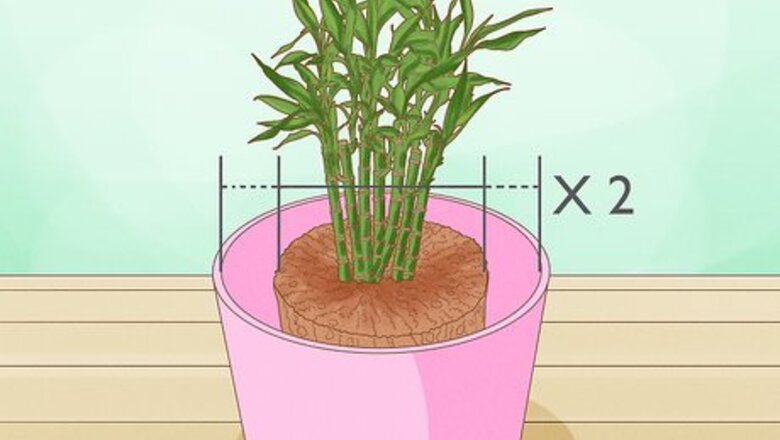
views
X
Research source
– or has been growing in water, not soil
Planting Bamboo Indoors
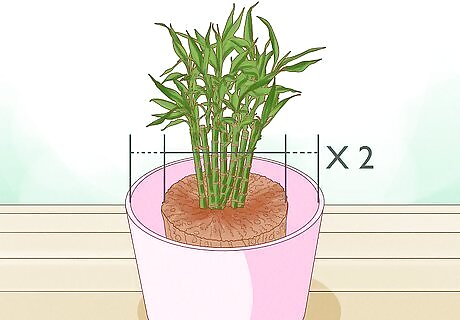
Find a wide, squat pot. Choose a container with twice the diameter of the root ball, or with at least 2 inches (5 cm) of space between the root ball and the sides. Good drainage is key to the survival of most bamboo species, so make sure there are sizeable holes in the base of the pot. Line the container with plastic root barrier if it is cement (which can damage bamboo) or wood (which lasts longer if protected from moisture).

Consider a humidity tray. Bamboo loves humidity, which can make indoor growing a challenge. Keeping water under the bamboo without letting it soak the roots is the easiest way to add moisture to the air. There are two ways to set this up: Pebble tray1. Fill a tray with a layer of pebbles.2. Add a shallow layer of water to the tray.3. Place the pot on top of the pebbles, without touching the water. Gravel1. Put a layer of gravel in the bottom of the pot.2. Place the pot in a shallow tray of water.
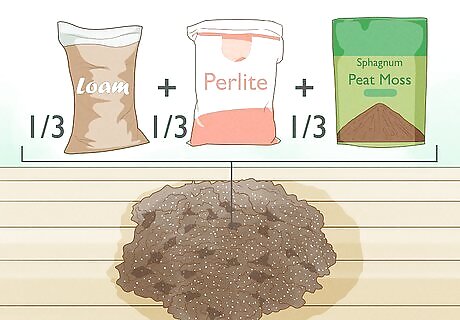
Fill with well-draining soil. Bamboo needs a soil with light to moderate density: fast-draining, but able to hold moisture. You can use a standard potting mix, or make your own from ⅓ loam, ⅓ perlite (or washed sand), and ⅓ peat moss (or well-rotted compost). Most bamboo can tolerate a wide range of well-draining soils, so the exact composition won't make or break your plants. You can use decent quality soil from your garden instead of potting soil. Avoid heavy clay soil, which drains poorly and is difficult to improve. Bamboo tends to do best in slightly acidic soil, with a pH between 5.5 and 6.5, but most species tolerate a pH up to 7.5. Most soil falls into this range.
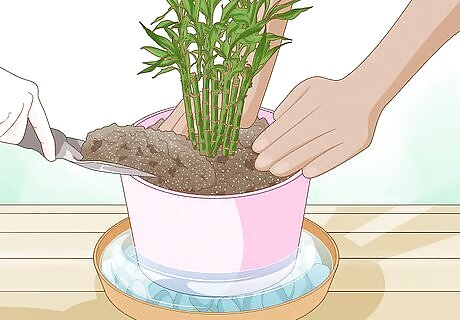
Plant your bamboo at a shallow depth. Keep the stem and the top of the root ball above the level of the soil to prevent rot. Press the soil down to get rid of air bubbles, and water in the plant with a good soak. If your bamboo came rootbound, cut it out at the edge of the pot with a clean knife. It's probably had trouble getting water, so soak the root ball (but not the stem) for 20 minutes before planting.
Caring for Your Indoor Bamboo
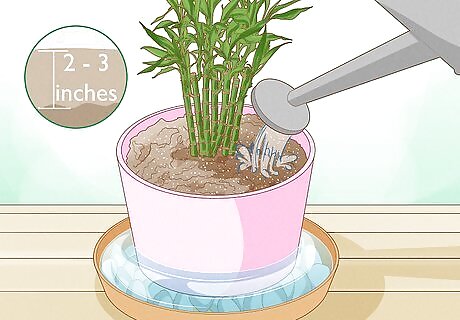
Water your bamboo carefully. This is the most difficult part of growing bamboo indoors, since bamboo is both thirsty and vulnerable to overwatering. To start out, water until a little water runs out the base. Let the top 2 or 3 inches (5–7.5 cm) of soil dry out before each watering session. If the soil stays moist for more than a day or two, reduce the amount of water. If the top of the soil is drying out quickly, dig down to 4 inches (10 cm) deep to check for moisture. This depth should stay lightly moist most of the time, especially during the first three months after planting.
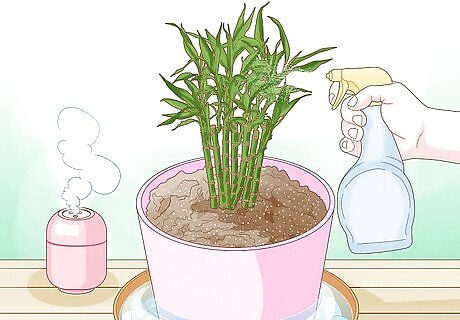
Keep it humid. Most bamboo plants prefer humid air, especially in hot weather. As long as you avoid overwatering, any one of the following should keep your plant happy: Place the pot over a humidity tray, as described in the planting section above. Lightly mist the leaves with a spray bottle every couple days. Run a humidifier in the room. Keep plants close together (but be aware this increases the risk of disease).
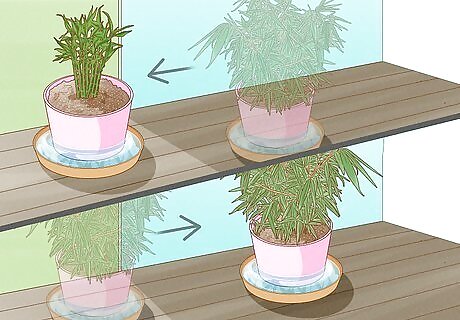
Find the right light level for your species. If you know the species name of your bamboo, look it up to find specific recommendations. If your plant needs more light than your climate provides, install evening grow lights. If you don't know the species, start with these rules of thumb: Needs more light:–plants with small leaves–tropical species–plants kept in warm rooms Needs less light:–plants with large leaves–temperate species during dormant winter periods–plants kept in cool rooms
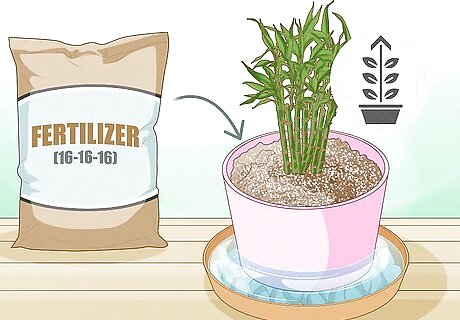
Fertilize your bamboo plant. Bamboo grows quickly as long as it has room in the container, and needs extra nutrients to support this growth. A dose of slow-release fertilizer at the beginning of the growing season is a good way to provide a steady supply. You can use a balanced fertilizer such as 16-16-16, or a high nitrogen (N) fertilizer such as 30-10-10. The high nitrogen option discourages flowering, which weakens many bamboo species. Warning:–Do not fertilize within 6 months of buying. Most plants get enough fertilizer from the nursery.–Avoid seaweed-based fertilizers due to excessive salt content.

Prune regularly. Most bamboo is very tolerant of pruning, so don't hesitate to shape it once it is established and healthy: Cut withered, stunted, or excess stems (culms) at soil level. To prevent a stem from growing above a certain height, cut it just above a node (branching point). Thin branches regularly if you want to encourage vertical growth. Remove lower branches for aesthetics.
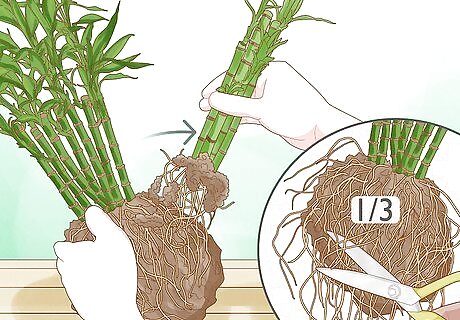
Re-pot or divide when the bamboo outgrows its container. Bamboo can grow in two different patterns depending on species. "Runners" send out long shoots to start new plants, and will spiral around a large container within three to five years. "Clumpers" grow steadily outward, and may last up to six years in the same pot. Any bamboo plant needs a transplant to a larger pot once it becomes rootbound. Once the roots have reached their maximum growing point, you just need to increase the size of the pot and re-plant. To restrict growth, instead dig up the plant, cut away about ⅓ of the roots, and replant in the same container with fresh potting mix. You can propagate most bamboo plants by cutting the stalks and replanting in separate containers. This does not work on bamboo with no hole in the center of the stalks, or only a very small hole.
Troubleshooting
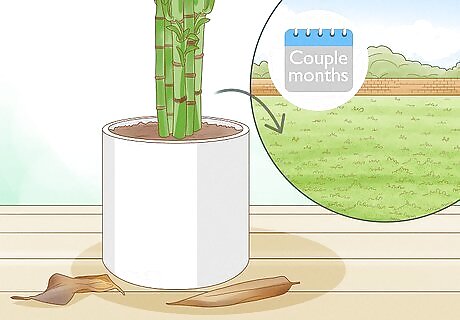
Find the cause of leaf drop. It is fairly common for a bamboo plant to lose a lot of leaves when moved indoors or transplanted. As long as the new leaves at the ends of branches look healthy, the plant should recover. If those leaves drop or look unhealthy, a couple months outdoors (if climate allows) can help recovery. If your plant has been in the same place for a while, look into other possible causes: Temperate species often drop leaves during low-light conditions. A cool, low-light dormant period in winter is good for these plants, and reduces leaf drop. The fewer green leaves there are, the less water the plant needs. Many species drop leaves in spring (or less commonly, fall), gradually replacing them with new ones. If there's a mix of green leaves, yellow leaves, and new, unfurling leaves, the plant is probably fine.

Fix curling or drooping leaves. If the sides of the leaves roll inward, the plant needs watering. (Photosynthesis consumes water, so the plant is reducing it by avoiding sunlight.) If the leaves droop downward, the plant is overwatered, or the soil is not draining fast enough. Overwatering is more dangerous than under-watering. Waiting to water until the leaves curl slightly will usually not harm the plant.
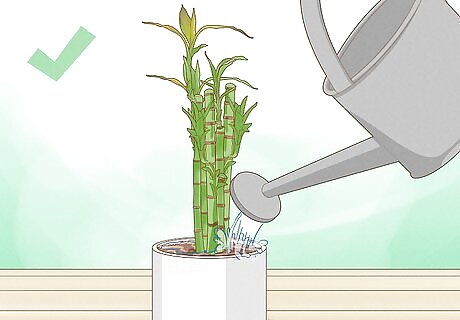
Respond to yellow leaves. If your bamboo is turning yellow outside of the dormant season, this could mean several different things: If they look dry and the tips are brown or curling upward, the plant needs more water. It may be rootbound and in need of a larger pot. Leaves that slowly become paler and more yellow usually have a nutrient deficiency. Add fertilizer with added minerals. A sudden color change after fertilizing points to over-fertilizing. Treat this problem by removing any remaining fertilizer and watering abundantly to leach out the excess minerals.
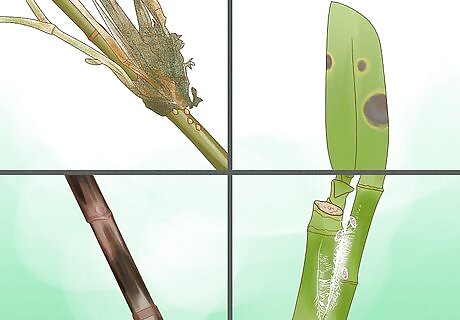
Respond to insects and disease. Indoor bamboo plants are more vulnerable to these problems, especially if there is low air flow in the room. If there is a light insect infestation, wash the leaves with insecticidal soap, or spray it outdoors with an insecticide spray. If this doesn't work, or if you think the plant has a disease, try to identify it and respond: A black "sooty" mold is usually caused by insects. Remove aphids and ants. Circular fungus rings or grey/brown scale usually do not harm the plant. An anti-fungus treatment from a garden store can remove it. Wet, rotting patches are a sign of overwatering, but may be helped along by infestations. Dry them out and treat with insecticide or fungicide. Sticky white webbing may hide bamboo mites or other insects. Spray it off and apply insecticide. There are over 1,000 species of bamboo, so no one guide will cover all problems. If your plant has a disease that doesn't match the description above, consult a local garden center or university agricultural extension about disease in your area.














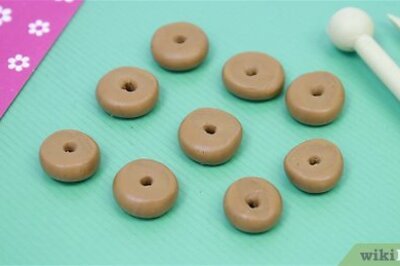
Comments
0 comment